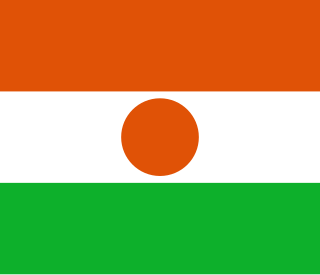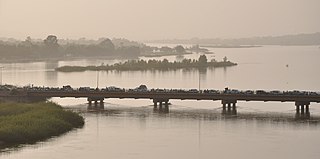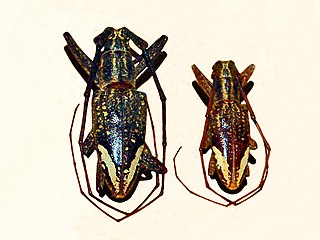Related Research Articles

Niger or the Niger, officially the Republic of the Niger, is a landlocked country in West Africa named after the Niger River. Niger is a unitary state bordered by Libya to the northeast, Chad to the east, Nigeria to the south, Benin and Burkina Faso to the southwest, Mali to the west, and Algeria to the northwest. Niger covers a land area of almost 1,270,000 km2 (490,000 sq mi), making it the second-largest landlocked country in West Africa. Over 80% of its land area lies in the Sahara Desert. The country's predominantly Muslim population of about 22 million live mostly in clusters in the far south and west of the country. The capital and largest city is Niamey, located in Niger's southwest corner.

The Niger River is the main river of West Africa, extending about 4,180 km (2,600 mi). Its drainage basin is 2,117,700 km2 (817,600 sq mi) in area. Its source is in the Guinea Highlands in southeastern Guinea near the Sierra Leone border. It runs in a crescent through Mali, Niger, on the border with Benin and then through Nigeria, discharging through a massive delta, known as the Niger Delta, into the Gulf of Guinea in the Atlantic Ocean. The Niger is the third-longest river in Africa, exceeded only by the Nile and the Congo River. Its main tributary is the Benue River.

Niger-Congo is a hypothetical language family spoken over nearly the entirety of sub-Saharan Africa. It unites the Mande languages, the Atlantic-Congo languages, and possibly several smaller groups of languages that are difficult to classify. If valid, Niger-Congo would be the world's largest in terms of member languages, the third-largest in terms of speakers, and Africa's largest in terms of geographical area. It is generally considered to be the world's largest language family in terms of the number of distinct languages, just ahead of Austronesian, although this is complicated by the ambiguity about what constitutes a distinct language; the number of named Niger-Congo languages listed by Ethnologue is 1,540.

Niamey is the capital and largest city of Niger. Niamey lies on the Niger River, primarily situated on the east bank. Niamey's population was counted as 1,026,848 as of the 2012 census. As of 2017, population projections show the capital district growing at a slower rate than the country as a whole, which has the world's highest fertility rate.

The Niger national football team represents Niger in international football through the Nigerien Football Federation, a member of Confederation of African Football (CAF). Niger plays in the colors of the flag of Niger, white, green and orange. Their nickname comes from the Dama gazelle, native to Niger, the Hausa name of which is Meyna or Ménas The Dama appears on their badge in the colors of the national flag.

Niger is a state in the Middle Belt region of Nigeria and the largest state in the country. The state's capital is at Minna. Other major cities are Bida, Kontagora and Suleja. It was formed in 1976 when the then North-Western State was bifurcated into Niger State and Sokoto State. It is home to Ibrahim Babangida and Abdulsalami Abubakar, two of Nigeria's former military rulers. The Nupe, Gbagyi, Kamuku, Kambari, Gungawa, Hun-Saare, Hausa and Koro form the majority of numerous indigenous tribes of Niger State.

Pelargoderus rubropunctatus is a species of beetle belonging to the family Cerambycidae.

Pelargoderus marginipennis is a species of beetle belonging to the family Cerambycidae.

Pelargoderus is a genus of beetle belonging to the family Cerambycidae.
Pelargoderus albopunctatus is a species of beetle in the family Cerambycidae. It was described by Stephan von Breuning in 1980.
Pelargoderus alcanor is a species of beetle in the family Cerambycidae. It is known from Newman in 1842, originally under the genus Monohammus. It is known from Sulawesi and the Philippines.
Pelargoderus arouensis is a species of beetle in the family Cerambycidae. It was described by James Thomson in 1857, originally under the genus Rhamses. It is known from Papua New Guinea and Moluccas.
Pelargoderus basalis is a species of beetle in the family Cerambycidae. It was described by Charles Joseph Gahan in 1907, originally under the genus Epepeotes.
Pelargoderus bipunctatus is a species of beetle in the family Cerambycidae. It was described by Dalman in 1815. It is known from Java.
Pelargoderus cincticornis is a species of beetle in the family Cerambycidae. It was described by Ritsema in 1895. It is known from Borneo.
Pelargoderus djampeanus is a species of beetle in the family Cerambycidae. It was described by Stephan von Breuning in 1960.
Pelargoderus flavicornis is a species of beetle in the family Cerambycidae. It is known from Charles Joseph Gahan in 1888. It is known from Sumatra.
Pelargoderus fulvoirroratus is a species of beetle in the family Cerambycidae. It was described by Blanchard in 1853. It is known from Moluccas.
Pelargoderus luteosparsus is a species of beetle in the family Cerambycidae. It is known from Masaki Matsushita in 1935, originally under the genus Nanyohammus. It feeds on Theobroma cacao and Artocarpus altilis.
Pelargoderus semitigrinus is a species of beetle in the family Cerambycidae. It was described by Ritsema in 1885.
References
- ↑ BioLib.cz - Pelargoderus niger. Retrieved on 8 September 2014.